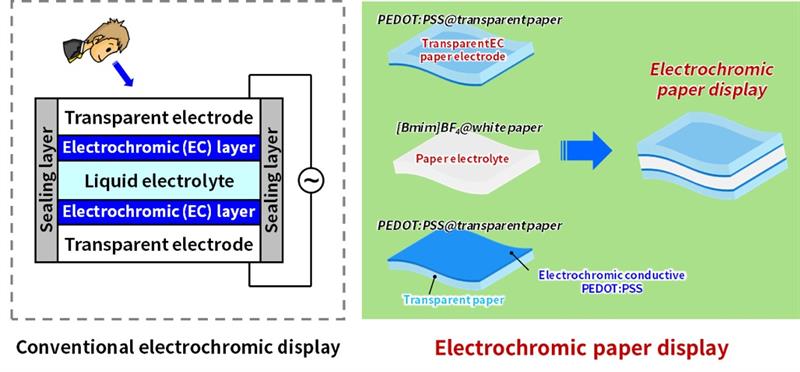Osaka explained the technology combines a ‘transparent paper’ with high transparency (90% of visible-light transmittance of paper made from cellulose nanofibers) and a conventional ‘white paper’ made from cellulose pulp fibres, which fabricates a highly transparent electrode and a white electrolyte with high visibility.
In EC devices, when voltage is applied to a transparent EC electrode, ions or electrons move into the EC layer in the electrolyte (ionic liquid), resulting in coloration or decolsoration. However, with conventional EC devices, sealing was necessary for preventing leakage of the electrolyte. This meant making thin films was difficult, and EC performance was compromised due to evaporation of the electrolyte.
A group of researchers led by Hirotaka Koga at Oksaka, claim to have succeeded in preparing a paper electrolyte by supporting a non-volatile electrolyte (1-butyl-3-methylimidazolium tetrafluoroborate [bmim]BF4) on the surface of cellulose pulp fibres through hydrogen bonding. Furthermore, the team said it managed to evenly coat conducting polymers with EC function, poly(3,4-ethylenedioxythiophene) poly (styrenesulfonate) (PEDOT:PSS), onto the entire surface of the transparent paper made from cellulose nanofibres.
By sandwiching the as-prepared LiClO4/[bmim]BF4@paper electrolyte between EC conductive PEDOT:PSS-coated transparent cellulose nanofiber papers (denoted as PEDOT:PSS@nanopapers) as a transparent EC electrode, the team explained it was able to fabricate an EC paper device.
| Below: Schematic of conventional electrochromic display (left) and electrochromic paper display (right) |

According to Osaka, this EC device resolves the sealing issue conventional devices encounter and also results in a “flexible and easily bent” device. In addition, Osaka adds that a white paper electrolyte with high optical reflectance enhances the visibility of the EC displays.
The team said its creation has resulted in a new application for paper – a material which has traditionally acted as a medium on which to display information by writing and printing – as a display using electricity.
Osaka added it has succeeded in developing various paper-based electronic devices, such as memory, transistors, antennas, and supercapacitors. Furthermore, if these technologies are integrated, it believes paper-based electronic books may be possible as well.













